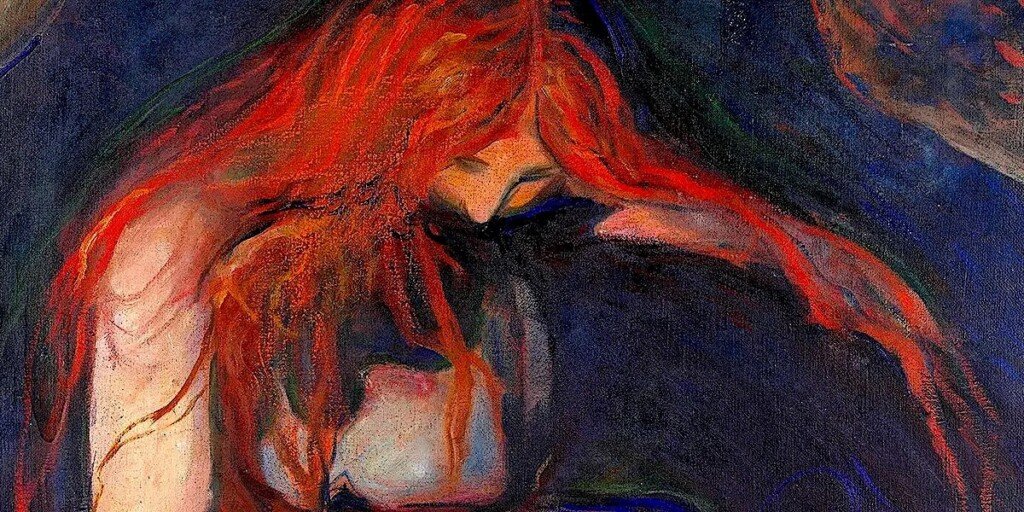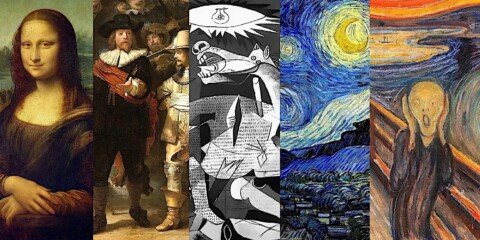Introduction to an Enigmatic World: My First Impression
The first impression I got from Edvard Munch’s Love and Pain, more commonly known today as The Vampire, was powerful. It stung me with a lot of emotion. It is an incredibly intimate yet disturbingly living theme — a half-remembered dream — . The 1895 expressionist masterpiece is full of contradiction: it speaks of tenderness and danger; it is both touching and painful.
After you have seen it for the first time, you feel conflicting emotions. These emotions can only be described as dichotomous. We have sought the magic in this painting. It has cast its spell over generations. Shall we explore its different layers together?

The Real Title Is Not "The Vampire"
Before exploring it, we quickly resolve a curious little fact: the title was never specifically declared by Edvard Munch. His title for the work was never “The Vampire”. The critic inferred this title. It was a name applied that took on a life of its own from one critic to the next. Eventually, it was assigned by popular acclaim-nature. Munch humbly comments, “It is just a woman kissing a man on his neck.”
Even before the majority of us chose to imagine a vampire, we saw it. It was instantly clear why this reading is still propagated today. The lady with the flaring red hair is like the fire for a hearth. She bloodies around the man who is consolingly cuddled into a corner. He lies with his head in submission hidden beneath her closed, moistened eyes. Her dynamic, titanic body cascades above each shoulder, its existence drapes him completely in its embrace.
Is this a kiss, or is it a bite into gory darkness? Love, or all the other delayed things? This paradox-its beauty merged with destruction-makes Love and Pain so striking.

Looking At It Closely: The Picture is Emotional Yet Tense.
To all appearances, the composition is quiet figures trapped in a private moment. But the longer one stares at it, the more charged it becomes.
The installation’s strongest telling section is undoubtedly found in the man bending ahead. He is almost collapsing under the weight of his lover’s embrace. His face turned away, hidden from the viewer, he is either in pain or seeking comfort. She holds him with the stillness to be both nurturing and consuming.
The most haunting quality of this scene is found in the way Munch’s use of visual elements blurs the difference between consolation and surrender:
- The red hair, thick and streaming of the woman — it’s a flow of blood, intensifying the vampire metaphor.
- A dark, heavy background and rough brushstrokes convey psychological tension.
- There is no eye contact, no clarity. Only an emotion distilled and unspoken.
This ambiguity allows for various interpretatioequally right, all equally intense.

An Obsession With Six Different Images
Did you know that Munch, sometime between 1893 and 1895, painted six versions of Love and Pain? It wasn’t just a matter of repeating the work. Munch was seized by an obsession. He went back to the scene again and again. He carved it up and reinterpreted it, like a director reshooting the same scene under different lighting.
Versions spread out into the next collections:
- Three versions lie with the Munch Museum in Oslo.
- One version is held in the Gothenburg Art Museum, Sweden.
- One version is with a private collector.
- Rumors state that one is missing: a real-world mystery.
In 1988, one version was stolen from the Munch Museum and then recovered in the same year. In 2008, another version sold for $38.2 million at Sotheby’s, cementing its status as the highest price ever paid for a Munch painting at that time.
What drove Munch to revisit this painting over and over? It is because it delineates the very theme that consumed him throughout his entire life. This theme is the entanglement of love, fear, and emotional dependency. Each version is similar. It also manifests slight variations. These include shifts in expression, pose, or color. They are like alternate endings to the same tragic tale.
Munch’s constant revisiting of the same theme invites us to consider the idea of “completion” in art. When does the emotional vision of a piece reach its peak? This relentless striving marks the very human quality of “incompleteness” in creativity itself. What if the most potent state of a work is not the final state? What if it is not the state intended by its artist?
These philosophical questions intrigue you. We recently published an article. It sheds some light on why some of the greatest masterpieces throughout history stay “unfinished.” This can happen whether by design or circumstance. A deep-dive into On the Concept of “Unfinished” in Art: 5 Masterpieces That Defy Completion explores these ideas. It calls to mind Pablo Picasso’s famous remark: “Art is never finished, only abandoned.”

The Real Question: What Do You See?
More poignant and powerful than any lesson in pictorial narratives is the question of what one reflects upon. Munch’s painting does not answer but raises such questions as,
- Is this an act of tender endearment or an embrace of dominance?
- Is love in its basic form nurturing or destructive?
- Is anguish a natural outcome of deep emotional bonding?
Some notice a woman calming a broken man; others see a vampire draining him of his lifeblood. Where the truth lies is probably somewhere in between or is liable to shift depending on who is observing.

Love and Pain, Still Relevant Today
Over a century later, Love and Pain still speaks to us. Why? Because it captures an emotional paradox that never goes away. Love is beautiful — and sometimes, it hurts. Sometimes, we surrender to it. Other times, we feel devoured by it.
The painting leaves us with one final, powerful question: Can love truly be a vampire? That’s for each of us to answer.
If you haven’t seen Love and Pain in person, take a moment to find one of the versions online. Look closely. it just a passionate kiss or the embrace of a vampire?
Have you ever seen a work of art that made you feel two opposing emotions at once? I’d love to hear your story.
Written by Discoverer of ART
Editor, curator, publisher
Twitter (X) – @DesignResource_






